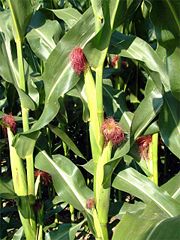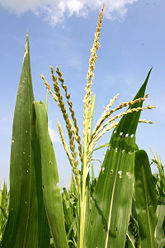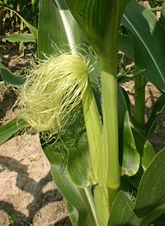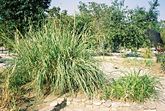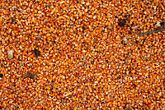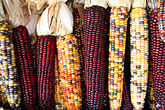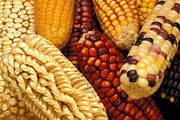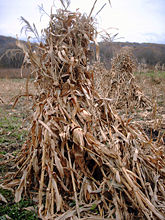Maize
2008/9 Schools Wikipedia Selection. Related subjects: Plants
| Maize | ||||||||||||||
|---|---|---|---|---|---|---|---|---|---|---|---|---|---|---|
 |
||||||||||||||
| Scientific classification | ||||||||||||||
|
||||||||||||||
| Binomial name | ||||||||||||||
| Zea mays L. |
Maize (IPA: /ˈmeɪz/) (Zea mays L. ssp. mays), known as corn in some countries, is a cereal grain domesticated in Mesoamerica and subsequently spread throughout the American continents. After European contact with the Americas in the late 15th and early 16th century, maize spread to the rest of the world.
Maize is the most widely grown crop in the Americas (270 million tonnes annually in the United States alone). Hybrid maize, due to its high grain yield as a result of heterosis ("hybrid vigour"), is preferred by farmers over conventional varieties. While some maize varieties grow up to 7 metres (23 ft) tall in certain locations, most commercially grown maize has been bred for a height of 2.5 metres (8 ft). Sweet corn is usually shorter than field-corn varieties.
Naming conventions
The term maize derives from the Spanish form (maíz) of the indigenous Taino term for the plant, and is the form most commonly heard in the United Kingdom. In the United States, Canada and Australia, the usual term is corn, which originally referred to any grain (and still does in Britain), but which now refers exclusively to maize, having been shortened from the form "Indian corn" (which currently, at least in the U.S., is often used to refer specifically to multi-colored "field corn" cultivars).
Physiology
Maize stems superficially resemble bamboo canes and the internodes can reach 20–30 centimetres (8–12 in). Maize has a very distinct growth form; the lower leaves being like broad flags, 50–100 centimetres long and 5–10 centimetres wide (2–4 ft by 2–4 in); the stems are erect, conventionally 2–3 metres (7–10 ft) in height, with many nodes, casting off flag-leaves at every node. Under these leaves and close to the stem grow the ears. They grow about 3 centimetres a day.
The ears are female inflorescences, tightly covered over by several layers of leaves, and so closed-in by them to the stem that they do not show themselves easily until the emergence of the pale yellow silks from the leaf whorl at the end of the ear. The silks are elongated stigmas that look like tufts of hair, at first green, and later red or yellow. Plantings for silage are even denser, and achieve an even lower percentage of ears and more plant matter. Certain varieties of maize have been bred to produce many additional developed ears, and these are the source of the "baby corn" that is used as a vegetable in Asian cuisine.
Maize is a facultative long-night plant and flowers in a certain number of growing degree days > 50 °F (10 °C) in the environment to which it is adapted. The magnitude of the influence that long nights have on the number of days that must pass before maize flowers is genetically prescribed and regulated by the phytochrome system. Photoperiodicity can be eccentric in tropical cultivars, while the long days characteristic of higher latitudes allow the plants to grow so tall that they do not have enough time to produce seed before being killed by frost. These attributes, however, may prove useful in using tropical maize for biofuels.
The apex of the stem ends in the tassel, an inflorescence of male flowers. Each silk may become pollinated to produce one kernel of corn. Young ears can be consumed raw, with the cob and silk, but as the plant matures (usually during the summer months) the cob becomes tougher and the silk dries to inedibility. By the end of the growing season, the kernels dry out and become difficult to chew without cooking them tender first in boiling water. Modern farming techniques in developed countries usually rely on dense planting, which produces on average only about 0.9 ears per stalk because it stresses the plants.
The kernel of corn has a pericarp of the fruit fused with the seed coat, typical of the grasses. It is close to a multiple fruit in structure, except that the individual fruits (the kernels) never fuse into a single mass. The grains are about the size of peas, and adhere in regular rows round a white pithy substance, which forms the ear. An ear contains from 200 to 400 kernels, and is from 10–25 centimetres (4–10 inches) in length. They are of various colors: blackish, bluish-gray, red, white and yellow. When ground into flour, maize yields more flour, with much less bran, than wheat does. However, it lacks the protein gluten of wheat and therefore makes baked goods with poor rising capability.
A genetic variation that accumulates more sugar and less starch in the ear is consumed as a vegetable and is called sweet corn.
Immature maize shoots accumulate a powerful antibiotic substance, DIMBOA (2,4-dihydroxy-7-methoxy-1,4-benzoxazin-3-one). DIMBOA is a member of a group of hydroxamic acids (also known as benzoxazinoids) that serve as a natural defense against a wide range of pests including insects, pathogenic fungi and bacteria. DIMBOA is also found in related grasses, particularly wheat. A maize mutant (bx) lacking DIMBOA is highly susceptible to be attacked by aphids and fungi. DIMBOA is also responsible for the relative resistance of immature maize to the European corn borer (family Crambidae). As maize matures, DIMBOA levels and resistance to the corn borer decline.
Genetics
Many forms of maize are used for food, sometimes classified as various subspecies:
- Flour corn — Zea mays var. amylacea
- Popcorn — Zea mays var. everta
- Dent corn — Zea mays var. indentata
- Flint corn — Zea mays var. indurata
- Sweet corn — Zea mays var. saccharata and Zea mays var. rugosa
- Waxy corn — Zea mays var. ceratina
- Amylomaize — Zea mays
- Pod corn — Zea mays var. tunicata Larrañaga ex A. St. Hil.
- Striped maize - Zea mays var. japonica
This system has been replaced (though not entirely displaced) over the last 60 years by multi-variable classifications based on ever more data. Agronomic data was supplemented by botanical traits for a robust initial classification, then genetic, cytological, protein and DNA evidence was added. Now the categories are forms (little used), races, racial complexes, and recently branches.
Maize has 10 chromosomes (n=10). The combined length of the chromosomes is 1500 cM. Some of the maize chromosomes have what are known as "chromosomal knobs": highly repetitive heterochromatic domains that stain darkly. Individual knobs are polymorphic among strains of both maize and teosinte. Barbara McClintock used these knob markers to prove her transposon theory of "jumping genes", for which she won the 1983 Nobel Prize in Physiology or Medicine. Maize is still an important model organism for genetics and developmental biology today.
There is a stock centre of maize mutants, The Maize Genetics Cooperation — Stock Centre, funded by the USDA Agricultural Research Service and located in the Department of Crop Sciences at the University of Illinois at Urbana-Champaign. The total collection has nearly 80,000 samples. The bulk of the collection consists of several hundred named genes, plus additional gene combinations and other heritable variants. There are about 1000 chromosomal aberrations (e.g., translocations and inversions) and stocks with abnormal chromosome numbers (e.g., tetraploids). Genetic data describing the maize mutant stocks as well as myriad other data about maize genetics can be accessed at MaizeGDB, the Maize Genetics and Genomics Database.
In 2005, the U.S. National Science Foundation (NSF), Department of Agriculture ( USDA) and the Department of Energy (DOE) formed a consortium to sequence the maize genome. The resulting DNA sequence data will be deposited immediately into GenBank, a public repository for genome-sequence data. Sequencing the corn genome has been considered difficult because of its large size and complex genetic arrangements. The genome has 50,000–60,000 genes scattered among the 2.5 billion bases – molecules that form DNA – that make up its 10 chromosomes. (By comparison, the human genome contains about 2.9 billion bases and 26,000 genes.)
On February 26, 2008, researchers announced that they had sequenced the entire genome of maize.
Origin
There are several theories about the specific origin of maize in Mesoamerica:
- It is a direct domestication of a Mexican annual teosinte, Zea mays ssp. parviglumis, native to the Balsas River valley of southern Mexico, with up to 12% of its genetic material obtained from Zea mays ssp. mexicana through introgression.
- It derives from hybridization between a small domesticated maize (a slightly changed form of a wild maize) and a teosinte of section Luxuriantes, either Z. luxurians or Z. diploperennis.
- It underwent two or more domestications either of a wild maize or of a teosinte.
- It evolved from a hybridization of Z. diploperennis by Tripsacum dactyloides. (The term "teosinte" describes all species and subspecies in the genus Zea, excluding Zea mays ssp. mays.) In the late 1930s, Paul Mangelsdorf suggested that domesticated maize was the result of a hybridization event between an unknown wild maize and a species of Tripsacum, a related genus. However, the proposed role of tripsacum (gama grass) in the origins of maize has been refuted by modern genetic testing, negating Mangelsdorf’s model and the fourth listed above.
The first model was proposed by Nobel Prize winner George Beadle in 1939. Though it has experimental support, it has not explained a number of problems, among them:
- how the immense diversity of the species of sect. Zea originated,
- how the tiny archaeological specimens of 3500–2700 BCE (uncorrected) could have been selected from a teosinte, and
- how domestication could have proceeded without leaving remains of teosinte or maize with teosintoid traits until ca. 1100 BCE.
The domestication of maize is of particular interest to researchers—archaeologists, geneticists, ethnobotanists, geographers, etc. The process is thought by some to have started 7,500 to 12,000 years ago (corrected for solar variations). Recent genetic evidence suggests that maize domestication occurred 9,000 years ago in central Mexico, perhaps in the highlands between Oaxaca and Jalisco. The wild teosinte most similar to modern maize grows in the area of the Balsas River. Archaeological remains of early maize ears, found at Guila Naquitz Cave in the Oaxaca Valley, date back roughly 6,250 years (corrected; 3450 BCE, uncorrected); the oldest ears from caves near Tehuacan, Puebla, date ca. 2750 BCE. Little change occurred in ear form until ca. 1100 BCE when great changes appeared in ears from Mexican caves: maize diversity rapidly increased and archaeological teosinte was first deposited.
Perhaps as early as 1500 BCE, maize began to spread widely and rapidly. As it was introduced to new cultures, new uses were developed and new varieties selected to better serve in those preparations. Maize was the staple food, or a major staple, of most the pre-Columbian North American, Mesoamerican, South American, and Caribbean cultures. The Mesoamerican civilization was strengthened upon the field crop of maize; through harvesting it, its religious and spiritual importance and how it impacted their diet. Maize formed the Mesoamerican people’s identity. During the 1st millennium CE (AD), maize cultivation spread from Mexico into the Southwest and a millennium later into Northeast and southeastern Canada, transforming the landscape as Native Americans cleared large forest and grassland areas for the new crop.
It is unknown what precipitated its domestication, because the edible portion of the wild variety is too small and hard to obtain to be eaten directly, as each kernel is enclosed in a very hard bi-valve shell. However, George Beadle demonstrated that the kernels of teosinte are readily "popped" for human consumption, like modern popcorn. Some have argued that it would have taken too many generations of selective breeding in order to produce large compressed ears for efficient cultivation. However, studies of the hybrids readily made by intercrossing teosinte and modern maize suggest that this objection is not well-founded.
In 2005, research by the USDA Forest Service indicated that the rise in maize cultivation 500 to 1,000 years ago in what is now the southeastern United States contributed to the decline of freshwater mussels, which are very sensitive to environmental changes.
Production quantities and methods
| Top Maize Producers in 2005 |
|
| (million metric tons) | |
| 280 | |
| 131 | |
| 35 | |
| 21 | |
| 20 | |
| 15 | |
| 13 | |
| 12 | |
| 12 | |
| 11 | |
| World Total | 692 |
| Source: UN Food & Agriculture Organisation (FAO) |
|
Maize is widely cultivated throughout the world, and a greater weight of maize is produced each year than any other grain. While the United States produces almost half of the world's harvest, other top producing countries are as widespread as China, Brazil, France, Indonesia, India and South Africa. Worldwide production was over 600 million metric tons in 2003 — just slightly more than rice or wheat. In 2004, close to 33 million hectares of maize were planted worldwide, with a production value of more than $23 billion.
Because it is cold-intolerant, in the temperate zones maize must be planted in the spring. Its root system is generally shallow, so the plant is dependent on soil moisture. As a C4 plant (a plant that uses C4 carbon fixation), maize is a considerably more water-efficient crop than C3 plants (plants that use C3 carbon fixation) like the small grains, alfalfa and soybeans. Maize is most sensitive to drought at the time of silk emergence, when the flowers are ready for pollination. In the United States, a good harvest was traditionally predicted if the corn was "knee-high by the Fourth of July", although modern hybrids generally exceed this growth rate. Maize used for silage is harvested while the plant is green and the fruit immature. Sweet corn is harvested in the "milk stage", after pollination but before starch has formed, between late summer and early to mid-autumn. Field corn is left in the field very late in the autumn in order to thoroughly dry the grain, and may, in fact, sometimes not be harvested until winter or even early spring. The importance of sufficient soil moisture is shown in many parts of Africa, where periodic drought regularly causes famine by causing maize crop failure.

Maize was planted by the Native Americans in hills, in a complex system known to some as the Three Sisters: beans used the corn plant for support and in turn provided nitrogen from nitrogen-fixing bacteria which live on the roots of beans and other legumes; and squashes provided ground cover to stop weeds and inhibit evaporation by providing shade over the soil. This method was replaced by single species hill planting where each hill 60–120 cm (2–4 ft) apart was planted with 3 or 4 seeds, a method still used by home gardeners. A later technique was checked corn where hills were placed 40 inches apart in each direction, allowing cultivators to run through the field in two directions. In more arid lands this was altered and seeds were planted in the bottom of 10–12 cm (4–5 in) deep furrows to collect water. Modern technique plants maize in rows which allows for cultivation while the plant is young, although the hill technique is still used in the cornfields of some Native American reservations.
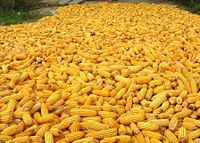
In North America, fields are often planted in a two- crop rotation with a nitrogen-fixing crop, often alfalfa in cooler climates and soybeans in regions with longer summers. Sometimes a third crop, winter wheat, is added to the rotation. Fields are usually plowed each year, although no-till farming is increasing in use. Many of the maize varieties grown in the United States and Canada are hybrids. Over half of the corn area planted in the United States has been genetically modified using biotechnology to express agronomic traits such as pest resistance or herbicide resistance.
Before about World War II, most maize in North America was harvested by hand (as it still is in most of the other countries where it is grown). This often involved large numbers of workers and associated social events. Some one- and two-row mechanical pickers were in use but the corn combine was not adopted until after the War. By hand or mechanical picker, the entire ear is harvested which then requires a separate operation of a corn sheller to remove the kernels from the ear. Whole ears of corn were often stored in corn cribs and these whole ears are a sufficient form for some livestock feeding use. Few modern farms store maize in this manner. Most harvest the grain from the field and store it in bins. The combine with a corn head (with points and snap rolls instead of a reel) does not cut the stalk; it simply pulls the stalk down. The stalk continues downward and is crumpled in to a mangled pile on the ground. The ear of corn is too large to pass through a slit in a plate and the snap rolls pull the ear of corn from the stalk so that only the ear and husk enter the machinery. The combine separates out the husk and the cob, keeping only the kernels.
Pellagra
When maize was first introduced outside of the Americas it was generally welcomed with enthusiasm by farmers everywhere for its productivity. However, a widespread problem of malnutrition soon arose wherever maize was introduced. This was a mystery since these types of malnutrition were not seen among the indigenous Americans under normal circumstances.
It was eventually discovered that the indigenous Americans learned long ago to add alkali — in the form of ashes among North Americans and lime (calcium carbonate) among Mesoamericans — to corn meal to liberate the B-vitamin niacin, the lack of which was the underlying cause of the condition known as pellagra. This alkali process is known by its Nahuatl (Aztec)-derived name: nixtamalization.
Besides the lack of niacin, pellagra was also characterized by protein deficiency, a result of the inherent lack of two key amino acids in pre-modern maize, lysine and tryptophan. Nixtamalisation was also found to increase the lysine and tryptophan content of maize to some extent, but more importantly, the indigenous Americans had learned long ago to balance their consumption of maize with beans and other protein sources such as amaranth and chia, as well as meat and fish, in order to acquire the complete range of amino acids for normal protein synthesis.
Since maize had been introduced into the diet of non-indigenous Americans without the necessary cultural knowledge acquired over thousands of years in the Americas, the reliance on maize elsewhere was often tragic. In the late 19th century pellagra reached endemic proportions in parts of the deep southern U.S., as medical researchers debated two theories for its origin: the deficiency theory (eventually shown to be true) posited that pellagra was due to a deficiency of some nutrient, and the germ theory posited that pellagra was caused by a germ transmitted by stable flies. In 1914 the U.S. government officially endorsed the germ theory of pellagra, but rescinded this endorsement several years later as evidence grew against it. By the mid-1920s the deficiency theory of pellagra was becoming scientific consensus, and the theory was proved in 1932 when niacin deficiency was determined to be the cause of the illness.
Once alkali processing and dietary variety was understood and applied, pellagra disappeared. The development of high lysine maize and the promotion of a more balanced diet has also contributed to its demise.
Pests
Insect pests
- Corn earworm (Helicoverpa zea)
- Fall armyworm (Spodoptera frugiperda)
- Common armyworm (Pseudaletia unipuncta)
- Stalk borer (Papaipema nebris)
- Corn leaf aphid (Rhopalosiphum maidis)
- European corn borer (Ostrinia nubilalis) (ECB)
- Corn silkfly (Euxesta stigmatis)
- Lesser cornstalk borer (Elasmopalpus lignosellus)
- Corn delphacid (Peregrinus maidis)
- Western corn rootworm (Diabrotica virgifera virgifera LeConte)
The susceptibility of maize to the European corn borer, and the resulting large crop losses, led to the development of transgenic expressing the Bacillus thuringiensis toxin. "Bt corn" is widely grown in the United States and has been approved for release in Europe.
Diseases
- Corn smut or common smut (Ustilago maydis): a fungal disease, known in Mexico as huitlacoche, which is prized by some as a gourmet delicacy in itself.
- Maize Dwarf Mosaic Virus
- Stewart's Wilt (Pantoea stewartii)
- Common Rust (Puccinia sorghi)
- Goss's Wilt (Clavibacter michiganese)
- Grey Leaf Spot
- Mal de Río Cuarto Virus (MRCV)
- Stalk and Kernal Rot
Uses
In the United States and Canada, the primary use for maize is as a feed for livestock, forage, silage or grain. "Feed corn" is being used increasingly for heating; specialized corn stoves (similar to wood stoves) are available and use either feed corn or wood pellets to generate heat. Silage is made by fermentation of chopped green cornstalks. The grain also has many industrial uses, including transformation into plastics and fabrics. Some is hydrolyzed and enzymatically treated to produce syrups, particularly high fructose corn syrup, a sweetener, and some is fermented and distilled to produce grain alcohol. Grain alcohol from maize is traditionally the source of bourbon whiskey. Increasingly ethanol is being used at low concentrations (10% or less) as an additive in gasoline ( gasohol) for motor fuels to increase the octane rating, lower pollutants, and reduce petroleum use (what is nowadays also known as "biofuels" and has been generating an intense debate regarding the human beings' necessity of new sources of energy, on the one hand, and the need to maintain, in regions such as Latin America, the food habits and culture which has been the essence of civilizations such as the one originated in Mesoamerica; the entry, January 2008, of maize among the commercial agreements of NAFTA has increased this debate, considering the bad labor conditions of workers in the fields, and mainly the fact that NAFTA "opened the doors to the import of corn from the United States, where the farmers who grow it receive multi-million dollar subsidies and other government supports. (...) According to OXFAM UK, after NAFTA went into effect, the price of maize in Mexico fell 70% between 1994 and 2001. The number of farm jobs dropped as well: from 8.1 million in 1993 to 6.8 million in 2002. Many of those who found themselves without work were small-scale maize growers."). However, introduction in the northern latitudes of the US of tropical maize for biofuels, and not for human or animal consumption, may potentially alleviate this.
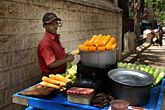
Human consumption of corn and cornmeal constitutes a staple food in many regions of the world. Corn meal is made into a thick porridge in many cultures: from the polenta of Italy, the angu of Brazil, the mămăligă of Romania, to mush in the U.S. or the food called sadza, nshima, ugali and mealie pap in Africa. It is the main ingredient for tortillas, atole and many other dishes of Mexican food, and for chicha, a fermented beverage of Central and South America. The eating of corn on the cob varies culturally. It is common in the United States but virtually unheard of in some European countries.
| Sweetcorn (seeds only) Nutritional value per 100 g (3.5 oz) |
||||||||||||||||||||||||
|---|---|---|---|---|---|---|---|---|---|---|---|---|---|---|---|---|---|---|---|---|---|---|---|---|
| Energy 90 kcal 360 kJ | ||||||||||||||||||||||||
|
||||||||||||||||||||||||
| Percentages are relative to US recommendations for adults. Source: USDA Nutrient database |
||||||||||||||||||||||||
Sweetcorn is a genetic variation that is high in sugars and low in starch that is served like a vegetable. Popcorn is kernels of certain varieties that explode when heated, forming fluffy pieces that are eaten as a snack.
Maize can also be prepared as hominy, in which the kernels are bleached with lye; or grits, which are coarsely ground corn. These are commonly eaten in the Southeastern United States, foods handed down from Native Americans. Another common food made from maize is corn flakes. The floury meal of maize ( cornmeal or masa) is used to make cornbread and Mexican tortillas. Teosinte is used as fodder, and can also be popped as popcorn.
Some forms of the plant are occasionally grown for ornamental use in the garden. For this purpose, variegated and coloured leaf forms as well as those with colourful ears are used. Additionally, size-superlative varieties, having reached 31 ft (9.4m) tall, or with ears 24 inches (60cm) long, have been popular for at least a century.
Corncobs can be hollowed out and treated to make inexpensive smoking pipes, first manufactured in the United States in 1869. Corncobs are also used as a biomass fuel source. Maize is relatively cheap and home-heating furnaces have been developed which use maize kernels as a fuel. They feature a large hopper which feeds the uniformly sized corn kernels (or wood pellets or cherry pits) into the fire.
An unusual use for maize is to create a maize maze as a tourist attraction. This is a maze cut into a field of maize. The idea of a maize maze was introduced by Adrian Fisher, one of the most prolific designers of modern mazes, with The American Maze Company who created a maze in Pennsylvania in 1993. Traditional mazes are most commonly grown using yew hedges, but these take several years to mature. The rapid growth of a field of maize allows a maze to be laid out using GPS at the start of a growing season and for the maize to grow tall enough to obstruct a visitor's line of sight by the start of the summer. In Canada and the U.S., these are called " corn mazes" and are popular in many farming communities.
Maize is increasingly used as a biomass fuel, such as ethanol, which as researchers search for innovative ways to reduce fuel costs, has unintentionally caused a rapid rise in food costs. This has led to the 2007 harvest being one of the most profitable corn crops in modern history for farmers. A biomass gasification power plant in Strem near Güssing, Burgenland, Austria was begun in 2005. Research is being done to make diesel out of the biogas by the Fischer Tropsch method.
As a result of the US Federal Government announcing its production target of 35 billion gallons of biofuels by 2017, ethanol production will grow to 7 billion gallons by 2010, up from 4.5 billion in 2006, boosting ethanol's share of corn demand in the US from 22.6 percent to 36.1 percent .
Maize is also used as fish bait called "dough balls". It is particularly popular in Europe for coarse fishing.
Stigmas from female corn flowers, known popularly as corn silk, are sold as herbal supplements.
Corn kernels can be used in place of sand in a sandbox-like enclosure for children's play.
In art
Maize has been an essential crop in the Andes since the pre-Columbian Era. The Moche culture from Northern Peru made ceramics from earth, water, and fire. This pottery was a sacred substance, formed in significant shapes and used to represent important themes. Maize represented anthropomorphically as well as naturally.
In the United States, maize itself is sometimes used for temporary architectural detailing when the intent is to celebrate local agricultural productivity and culture. A well-known example of this use is the Corn Palace in Mitchell, South Dakota, which utilizes cobs of colored maize to implement a design that is recycled annually.
